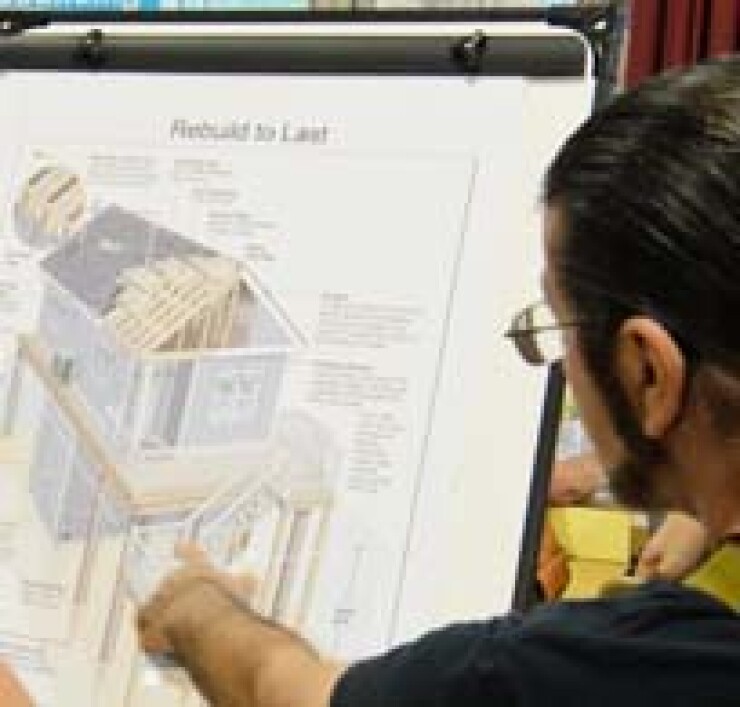
WE’RE HEARING Hurricane Sandy is back in the news, with New York City unveiling an ambitious plan to beef up storm defenses and HUD announcing a
Both the New York proposals and HUD’s competition are focused on rebuilding in ways that will diminish the damage the next time a hurricane slams into the nation’s most populous region.
But the attention is also bringing back to mind both the pain and the resilience that New York and New Jersey coastal communities experienced in the aftermath of the biggest storm to hit the region in more than a century.
Long Island mortgage banker Don Giorgio, president of United Northern Mortgage Bankers in Levittown, N.Y., got a firsthand look at how devastating the damage was and how frustrating the recovery can be. His home in Massapequa, a town on Long Island near the Atlantic Coast, was flooded and extensively damaged by Sandy, and he made it clear to me that he wouldn’t wish the hassles he and his neighbors went through on anyone.
He termed the insurance industry’s response to the storm “horrible.” For typically homeowners, understanding the nuances of what is covered and what is not was especially frustrating. (Earlier this year the insurance industry and mortgage servicers, who often administered homeowners insurance claims for their customers,
Determining what a policy is supposed to cover in the wake of a storm is another challenge, he said.
“It is a nightmare for the average person to understand what is happening,” he said. “I ended up having to hire a public adjuster because I could not navigate it at all.”
The public adjuster helps advocate for the homeowner with the insurance company’s claims adjuster. In return, they get a percentage of the claims payout for maximizing the homeowner’s claim amount.
“They are there to represent your best interest, to make sure what you are entitled to get from your insurance company arrives in your hands.”
One problem with the insurance coverage in New York is that the program used to estimate repair or replacement costs is based on national averages, and as anyone who has ever lived in New York State can tell you, construction and renovation activity in the Empire State is considerably more expensive than in most places.
There are also the inevitable questions about what is covered by homeowners insurance. Among the things typically not covered? Landscaping and outdoor infrastructure, such as fences. Giorgio said that in his neighborhood, fences and shrubs and just about all landscaping was washed away by the storm. The area looks like a new development now because of all the new landscaping, he told me.
For two weeks after the storm, Giorgio and his neighbors were without power, creating perhaps the most challenging period in the aftermath of the storm. He said the Long Island Power Authority was atrociously slow in getting power restored after the storm.
But the ongoing recovery from Hurricane Sandy has generated some bonding among neighbors, he said.
“I’ve been amazed at how resourceful people have become and how people banded together and became friends throughout this disaster,” Giorgio said.
But Giorgio sees a silver lining in the recovery effort, citing the resilience of New Yorkers in the wake of the storm and a surge in construction and renovation spending.
“Everyone in this area is now spending money to repair and renovate and improve their homes,” he said.
That is putting dollars into the economy that would not otherwise have been spent, he said.
While there are pockets of heavily hit areas that will take months to repair, for the most part the housing market has kind of returned to normal, he said. In fact, in New York City’s five boroughs as well as in Nassau and Suffolk counties on Long Island, a shortage of inventory is the biggest problem facing the housing market, Giorgio said.
And as for the mortgage business, the storm has created a spike in lending under the FHA’s 203k program, he said. That program provides purchase-rehabilitation financing, but homeowners can also refinance into a 203k loan to finance repairs and renovations. Northern United has been making a lot of these loans and has developed an expertise in the program, Giorgio said.
“A lot of people don’t know that it is available to them.”
Data from the Mortgage Bankers Association also seem to indicate that Sandy has not caused a spike in delinquencies and defaults along the New York and New Jersey coastal areas most affected by the storm. The Mortgage Bankers Association reported that delinquencies declined in New Jersey, New York and Connecticut during the first quarter of 2013.
“We expect further improvements in these states as we move through 2013,” said Michael Fratantoni, vice president of economics and research at the MBA, in a news release.
Ted Cornwell has covered the mortgage markets since 1990. He is a former editor of both Mortgage Servicing News and Mortgage Technology.





